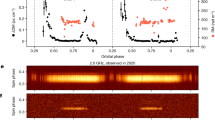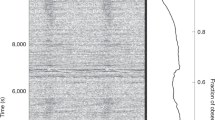Abstract
HARRISON1 has pointed out that the six radio pulsars with the smallest observed spin-down rates (Ṗ) are grouped together in a relatively small region of the sky, roughly in the direction of the galactic centre. To explain this particular effect he suggested that the intrinsic values of Ṗ are actually larger than the observed ones, because the barycentre of the Solar System would be accelerated (v̇≃10−6 cm s−2) in that direction. Harrison then suggested that this acceleration would be due to an hitherto undetected companion star of the Sun. He proposed a faint white, red (or even black) dwarf in a closed orbit, rather than a gas-accreting neutron star or black hole in an open orbit. We show here that a companion producing such an acceleration should almost certainly have been discovered because of its brightness in the infrared or visible region of the spectrum, depending on the character of the object. We conclude that Harrison's explanation is probably incorrect, and therefore we presume that the observed spin-down rates of these six pulsars (including the binary pulsar) are intrinsic and that their extreme values are due to the particular way in which the pulsars were formed. We show that the apparent clustering of these radio pulsars is a consequence of a strong observational selection effect and conclude that the distribution of all radio pulsars seems to be symmetric around the galactic centre.
This is a preview of subscription content, access via your institution
Access options
Subscribe to this journal
Receive 51 print issues and online access
$199.00 per year
only $3.90 per issue
Buy this article
- Purchase on Springer Link
- Instant access to full article PDF
Prices may be subject to local taxes which are calculated during checkout
Similar content being viewed by others
References
Harrison, E. R. Nature 270, 324–326 (1977).
Laubscher, R. E. Astr. Astrophys. 13, 426–436 (1971).
Rawlings, D. & Hammerton, M. Nature 240, 457 (1972).
Tarter, J. C. thesis, NASA (1977).
Staller, R. F. A. Astr. Astrophys. 42, 155–157 (1975).
Johnson, H. L., Mitchell, R. I., Iriarte, B. & Wiśniewsky, W. Z. Commun. lun. Plan. Lab. Univ. Arizona 4, 99–110 (1966).
Neugebauer, G. & Becklin, E. E. Scient. Am. 28–40 (1973).
Allen, C. W. Astrophysical Quantities 3rd edn, 144 (Athlone, London, 1973).
Veeder, G. J. Astr. J. 79, 1056–1072 (1974).
Weidemann, V. A. Rev. Astr. Astrophys. 6, 351–372 (1968).
Bondi, H. & Hoyle, F. Mon. Not. R. astr. Soc. 104, 273–282 (1944).
Novikov, I. D. & Thorne, K. S. in Black Holes, 343–450 (eds De Witt & De Witt) (Gordon & Breach, New York, 1973).
Eardley, D. M. & Press, W. H. A. Rev. Astr. Astrophys. 13, 381–422 (1975).
Taylor, J. H. & Manchester, R. N. Astr. J. 80, 794–806 (1975).
Wright, E. L. & Harrison, E. R. Nature 272, 649 (1978).
Author information
Authors and Affiliations
Rights and permissions
About this article
Cite this article
HENRICHS, H., STALLER, R. Has the Sun really got a companion star?. Nature 273, 132–134 (1978). https://doi.org/10.1038/273132a0
Received:
Accepted:
Issue Date:
DOI: https://doi.org/10.1038/273132a0
This article is cited by
-
The astrophysics of nanohertz gravitational waves
The Astronomy and Astrophysics Review (2019)
-
Are periodic mass extinctions driven by a distant solar companion?
Nature (1984)
-
Extinction of species by periodic comet showers
Nature (1984)
-
Energetic comets versus the Sun's companion
Nature (1979)
-
If the Sun has a companion…
Nature (1978)
Comments
By submitting a comment you agree to abide by our Terms and Community Guidelines. If you find something abusive or that does not comply with our terms or guidelines please flag it as inappropriate.



